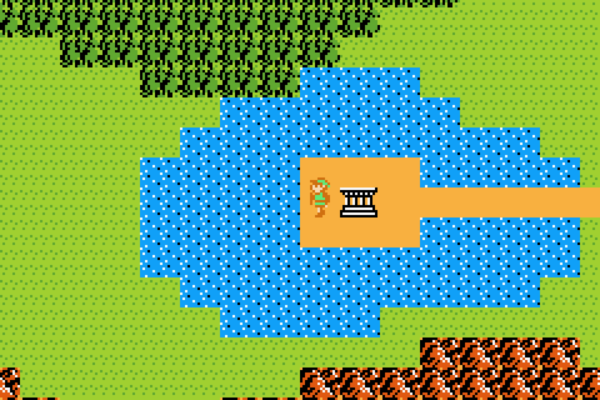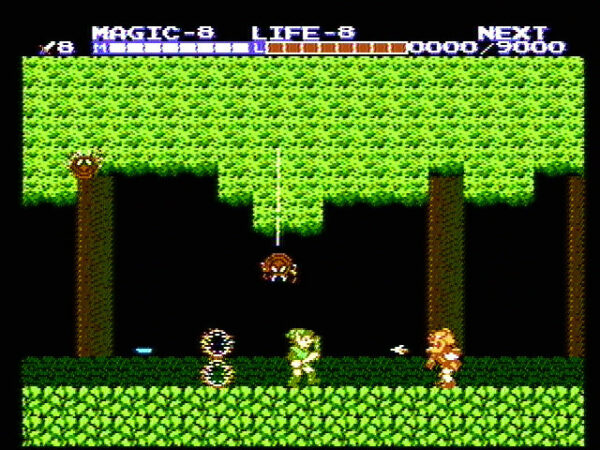Gaming has a rich history that spans multiple decades. To this end, The Last Word on Gaming Backlog is a series that looks back on titles across all generations. From the golden 8-bit era to the landscape-changing 64-bit scene and beyond, The LWOG Backlog’s aim is history. Following a history-making debut for the franchise, Nintendo followed up with the Nintendo Entertainment System sequel known as Zelda II: The Adventure of Link.
Zelda II: The Adventure of Link – An Overview
The original Legend of Zelda was a landmark action-adventure title. This goes without saying, but it’s difficult to truly articulate just how influential it was. Not only did it go on to inspire other titles within the same genre, but it sparked a franchise that’s still going strong today. However, this road hasn’t been without its detours, some starker than others. In fact, said detours began during the franchise’s infancy. Developed by Nintendo R&D 4, published by Nintendo, and released in Japan in 1987 and North America and Europe the year after, Zelda II: The Adventure of Link for NES took a much different approach.
Early in its development, Zelda II for NES was meant to be fundamentally different from the original title. Aside from a few individuals, an entirely different team was responsible for the sequel’s development. This becomes evident almost immediately after starting a new file, though we will dive deeper into this shortly. In any event, for better or worse, Zelda II went off the beaten path that the original game paved. Even with this reputation that the game developed over the years, is it worth going back to? Arm yourself up and prepare to awaken the princess as we discuss Zelda II: The Adventure of Link.
Story
Zelda II: The Adventure of Link is set 6 years following the first Legend of Zelda. Noting a strange crest-like design on the back of his hand, Link is consulted by Impa. Noticing this, Impa leads our hero to the North Castle, opening a sealed door to reveal a sleeping maiden by the name of Zelda. She was put under a spell by her brother’s wizard friend, who was irate when she refused to disclose the secrets of the Triforce. Now, with six crystals in his possession, Link must travel to six different places to restore the crystals, awake Zelda, and battle Ganon‘s followers as they attempt to revive their fallen evil leader.
As mentioned earlier, Zelda II is a direct sequel, making it one of the select games in the franchise to hold this distinction. This isn’t to say that one needs to play the original Legend of Zelda to play this one, as the narrative was seldom the drawing point of NES titles. Through its story, however, Zelda II expands the scope of the series, going even further than its predecessor, setting in motion what would be continued development for said series at large.
Gameplay

Zelda II: The Adventure of Link plays like a side-scrolling action RPG, a stark contrast to the top-down gameplay of the original Legend of Zelda. As Link, the player must visit towns, conquer palaces, and restore the aforementioned crystals in their quest to awaken Zelda. Along the way, Link will upgrade his arsenal by acquiring new magic spells and gaining experience points, allowing him to upgrade his stats. Though Zelda games have often been considered RPG-like, nowhere is this more evident than in the series’ second title.
Between towns, palaces, and other notable landmarks, the player will spend most of their time on the overworld map; this is where traveling to said locations takes place. During this, moving images denoting enemy encounters will appear, and by touching them, the player will enter side-scrolling battle sequences. This is where Link can gain experience and, in certain situations, even find items to make their quest easier. These battle sequences will also take place when the player enters any of the game’s six palaces.
As a side-scrolling adventure, Link must attack, block, and jump to defeat the game’s various foes. However, this is one of the areas where this game becomes divisive. To many players, combat can become too difficult for its own good, especially when encountering enemies with hard-to-predict attack patterns. Finding one’s way around the game’s world can be a challenge as well, especially with oftentimes cryptic advice given by NPCs, so don’t be surprised if you find yourself pulling up a walkthrough. Zelda II may have been innovative, but make no mistake that it has its detractors as well as supporters.

Presentation (Graphics and Sound)
Due to its side-scrolling nature, Zelda II: The Adventure of Link was able to showcase more detailed graphics than its predecessor. From the townspeople to the enemies to Link himself, every sprite is given more attention, resulting in characters with more personality from a visual standpoint. The same can be said for the game’s environments, from wooded areas to the palaces in question, as each makes use of the color palette that the NES was capable of. In terms of graphics, Zelda II was more than serviceable for its time.
Zelda II’s sound design is worth noting, too. Though Koji Kondo would become synonymous with the series over the years, the second entry’s composition is credited to Akito Nakatsuka, otherwise known as “Tsukasan.” Zelda II has only a handful of true songs, though they are all memorable; the dungeon theme became notable, especially for fans of the Super Smash Bros. series. Nakatsuka has composed for other NES titles, including Clu Clu Land, Excitebike, and Ice Climbers.
Replayability

For those looking to get into Zelda II, despite its gameplay quirks, you may be curious to know how long the adventure will last. On average, a straight shot to the end credits can last roughly 10 hours, though this number may vary depending on how reliant one is on a walkthrough. It’s also important to consider completionist walkthroughs, such as finding the various Heart Containers scattered throughout Hyrule. Finding each one can be an adventure in and of itself, so don’t be surprised if you find yourself playing this title longer than most. Hyrule is a big landscape and it’s one that, despite the game’s high challenge level, is begging to be explored.
In Closing
As history has shown, different isn’t always a negative. Following its commercial release, Zelda II: The Adventure of Link became a success, selling over 4 million units worldwide. Furthermore, it went on to become one of the top 10 best-selling NES games, sharing rarified air with other notable titles. For context, it sold more than Excitebike, Dragon Quest III, and the original Teenage Mutant Ninja Turtles. Zelda II wasn’t forgotten by Nintendo, either, as it made its way on everything from Virtual Console services and the NES Classic to, more recently, Nintendo Switch Online and the Game & Watch: Zelda device as well.
Zelda II may be one of the most divisive titles in the franchise and it’s easy to see why. It took the series in a different direction in its infancy instead of simply building upon the original title. Despite this, it would be interesting to see Nintendo build a new entry in the series with Zelda II’s gameplay philosophies in mind. Love it or hate it, it pushed the Legend of Zelda franchise further, ultimately leading to The Legend of Zelda: A Link to the Past for the Super Nintendo. This, however, is a story for another time.
Stay tuned to Last Word on Gaming for all the latest gaming news and reviews. Follow us on Facebook, Twitter, and join our Discord Server.
